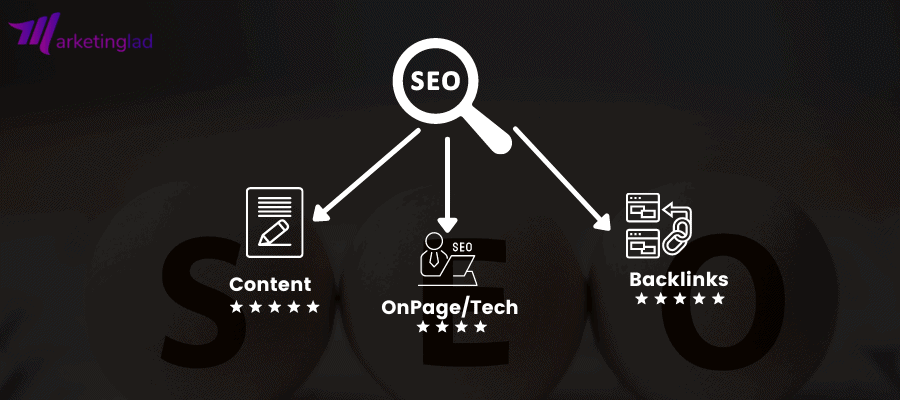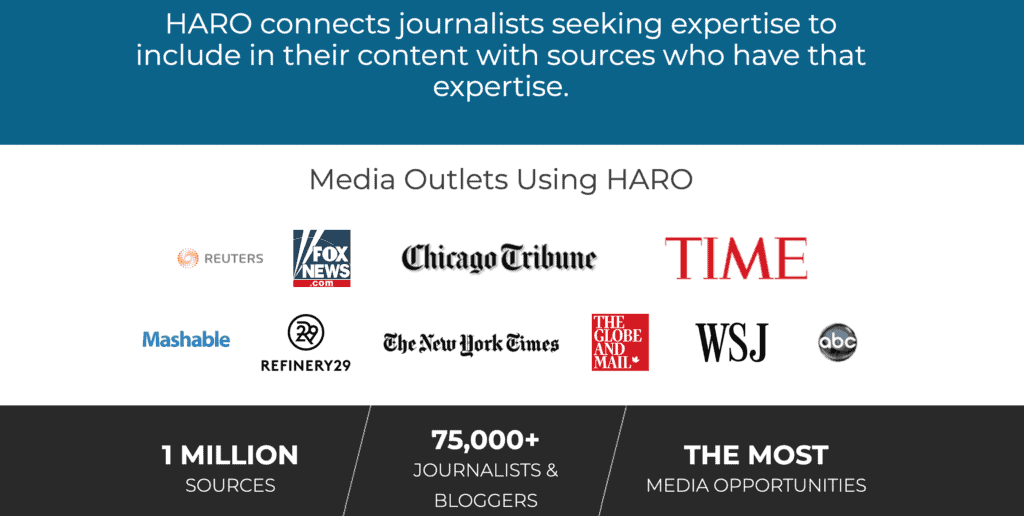Link-building is the process of receiving links from other relevant websites to your webpage. For example, Website A has a link that goes to Website B, which means Website B received a link.
The more high-quality backlinks of your website in relevant and niche-oriented sites, the better will be your chances to-
- Improve Organic traffic
- Move up your search rankings
- Web credibility
- Increasing leads, sales and revenues
The above can also be taken to be some of the major advantages of high-quality link building. Links are the foundation of Google’s ranking algorithms. In addition to high-quality content and mobile optimization, they are the third vital ranking factor on search engines.
Link building is one of the top factors that comes in Search Engine Optimisation.
Doing only content optimisation and working on technical SEO without link building is useless.
Link building is an essential part of SEO including other important aspects – Content, On-Page Optimisation and Technical SEO.
In the below image, you can understand the authority of each section. I have given link building 5 stars because it is one of the best ways to move up your rankings quickly on search engine result pages aka SERPs. Backlinks/Link building are also responsible to increase your domain authority/strength.

Other than improving rankings and authority, backlinks also help in increasing organic traffic and search impressions.
Let’s imagine you built a new website, published the content and did the on-page optimisation. Now to quickly move up your rankings, you need to get high authority backlinks to your website.
This is pretty much clear now!
In simple words, Acquiring backlinks from other websites is also known as Link Building.
Why Link Building is Important for SEO
Link building is crucial for SEO since it raises a website’s authority and trustworthiness. Inbound links from other high-quality and relevant websites serve as a vote of confidence in the content and information provided on the linked website.
Search engines, such as Google, use these inbound links as a way to determine the relevance, quality, and credibility of a website, which can impact its ranking in search results. As a result, having a strong link-building strategy can help to improve a website’s visibility and attract more organic traffic.
Now the backlinks Have Two Attributes
- Do-follow Backlinks
- No-follow Backlinks
Question: What is a do-follow backlink?
Do follow backlinks are the most useful links for building domain authority and improve rankings. SEO expert always checks the link types to ensure the link is a do-follow.
When the link is do-follow that means “Search engine bots can read or crawl on your link that is placed on another website, eventually, that generates an authority”
No matter what, only do-follow contextual backlinks pass the link juice to your website
Here is a quick tip: Always try to get a link from a website that has a good domain rating score. You can check the FREE domain rating score from various SEO tools.
Domain rating has many other names in the SEO field.
Don’t get confused!
SEO tools like Ahrefs named it Domain Rating, and other tools like Moz, Semrush and Ubersuggest named it Domain Authority, Authority Score and Domain Score. All of them are rating the domain strength and popularity of your domain from their different algorithms.
As I mentioned, all of them use different algorithms to measure your domain score. So your DA/DR/AS/DS might differ and oftentimes will not be the same.
If you are confused with SEO tools, Check out my published article on Ahrefs Vs Moz. These are the leading SEO tools.
Question: How to check a dofollow link?
It is as simple as opening google chrome from your laptop.
Now you know the importance of a do-follow link, It’s important to check on that, right?
I will share the two ways to check whether a link is dofollow or not.
- Basic HTML code:
< a href=”https://marketinglad.io” rel=”dofollow”>Example1
OR
< a href=”https://marketinglad.io” >Example2
OR
< a href=”https://marketinglad.io” rel=”external” >Example3
You can simply inspect the webpage and check. All of the above links are do-follow links because the “rel attribute” defines the link type and if there is no rel (check example 2) the link will remain a do-follow link.
- Check with a Moz chrome extension:
Moz chrome extension can also help in understanding the link attribute. Simply enable the chrome extension and check the link attribute without even having the knowledge of HTML.
Here are the steps to follow:
Click on the Moz extension.
You see a pencil-shaped icon, right.
Click on the pencil and you will get options like – followed, nofollowed, external and internal.
Just click on the followed, and you see all dofollow links in the green color, no coding is required.
Question: What is a nofollow backlink?
Nofollow backlinks have the rel”nofollow” attribute that tells search engines “do not crawl this link” and most likely nofollow links doesn’t make any impact on rankings and building domain rating.
Here is how the code looks like:
< a href=”https://marketinglad.io” rel=”nofollow”
The links you post on social media channels like – Facebook, Linkedin, Twitter and so on are always nofollow links. Those links don’t pass any link juice and crawlers ignore them.
In the same Moz Bar extension, you can click on the pencil and select nofollow, if the anchor’s color changes with purple that means the link has a nofollow attribute.
Normally, when users click on the link, they don’t know the difference between nofollow & dofollow. When it comes to search engines it has a huge difference.
That’s why always start link building with dofollow links.
Benefits of Link Building
Link-building is a process in search engine optimisation (SEO) where a website owner creates links from other websites to their site. The main benefits of link-building are:
Improved search engine rankings
Search engines like Google use links as a way to measure the popularity and credibility of a website. The more high-quality links a site has, the higher its rankings are likely to be.
Increased referral traffic
By building links on other relevant websites, you can drive more traffic to your site. Conversions, sales, and overall income may all rise as a result.
Increased brand visibility and credibility
By appearing on other websites, you can increase your brand visibility and establish yourself as a credible and trustworthy source of information.
Improved user experience
When links are placed on relevant websites, users can quickly and easily access the information they are looking for, leading to a better overall user experience.
Increased Domain Rating
Domain Rating (DR) is a metric used by Ahrefs to estimate the strength of a website’s backlink profile. A high DR score indicates a strong backlink profile, which can be achieved through link building. By building high-quality backlinks, you can improve your website’s DR and increase its visibility in search results.
In summary, link building can help to improve your website’s search engine rankings, increase referral traffic, enhance brand visibility and credibility, and improve the user experience.
How to Build Quality Links
Guest Blogging
Guest blogging is a digital marketing strategy where you write and publish articles on other websites to promote your website. The main purpose of guest blogging is to gain backlinks from the host website, which can help to increase your website’s visibility and authority in search engines like Google.
Backlinks from high-quality websites are considered valuable because they indicate that other websites trust your content and see it as relevant and valuable to their audience. To use guest blogging for link building effectively, it’s important to find websites that are relevant to your industry and audience and to write high-quality, informative articles that will be well-received by the host website’s audience.
Editorial Mentions
The editorial mentions refer to mentions of your website, brand, or products in articles or other editorial content without a direct link. Unlike traditional backlinks, editorial mentions do not provide a direct link to your website, but they can still be valuable for link-building and improving your website’s visibility and credibility.
Editorial mentions can help to establish your brand as an authority in your industry and increase awareness of your products or services among potential customers. They can also contribute to your website’s visibility and credibility in search engines, as mentions in credible, high-quality editorial content can signal to search engines that your brand is relevant and trustworthy.
To use editorial mentions for link building, focus on creating high-quality, valuable content and reach out to journalists, bloggers, and other content creators in your industry to let them know about your brand and offerings. Building relationships with these individuals and offering them valuable information or resources can increase the likelihood of them mentioning your brand in their content.
PR
Public relations (PR) is a marketing strategy that involves building and maintaining relationships between a company and its stakeholders, such as customers, employees, and the media. PR can be used for link-building by securing media coverage and editorial mentions of your brand in high-quality, authoritative publications.
When a reputable publication writes about your brand, it can lend credibility and visibility to your website, and these editorial mentions can be considered valuable by search engines. This can help to improve your website’s visibility and ranking in search results, as well as increase brand awareness and credibility among your target audience.
To use PR for link building, focus on creating a compelling story about your brand and reaching out to journalists and other media contacts who are relevant to your industry. Offer them valuable information and resources, and make it easy for them to write about your brand. Building strong relationships with media contacts can increase the likelihood of securing editorial mentions and media coverage in the future.
HARO

A platform called HARO, or Help a Reporter Out, connects journalists with sources for their pieces. As a source, you can respond to journalists’ queries and offer your expertise or insights to be included in their articles. This can be a valuable way to build backlinks to your website and increase visibility and credibility in search engines.
When a journalist quotes you or mentions your website in their article, they may include a backlink to your site. These backlinks are considered valuable because they come from credible, high-quality sources, and can help to establish your website as an authority in your industry.
To use HARO for link building, sign up as a source and regularly monitor the queries that journalists are posting. Respond to relevant queries with informative, valuable information, and make sure to include a link to your website in your response. Keep in mind that the goal is to provide value to journalists and their audience, so focus on offering useful insights and expertise, rather than solely promoting your brand.
Internal Linking
Internal linking is the act of creating links to other pages on your website. This can help to improve the user experience by making it easier for visitors to navigate your site and find related content. Internal linking can also help to distribute page authority and ranking power throughout your website, which can improve your overall search engine visibility.
In terms of link building, internal linking can be used to build quality links within your site. This can help to establish a clear hierarchy of importance for your pages and ensure that your most valuable content is easily accessible to both visitors and search engines.
To use internal linking for link building, start by identifying your most important pages and ensuring that they are linked to other relevant pages within your site. Use descriptive, relevant anchor text for these links, and try to balance the distribution of links and authority across your site to ensure that no one page is over-reliant on internal links for its ranking power. Regularly review and update your internal links to ensure that they are still relevant and effective.
Link-Building Strategies to Avoid
Black Hat Tactics
Black hat tactics are unethical and manipulative practices used to manipulate search engine rankings. These tactics violate search engine guidelines and can result in penalties or even a ban from the search engine. Examples of black hat tactics include keyword stuffing, cloaking, and hidden links.
Paid Links
Paid links are links that are purchased or traded to artificially boost a website’s search engine ranking. These links violate search engine guidelines and can result in penalties or a ban from the search engines.
Link Exchanges
Link exchanges refer to the practice of exchanging links with other websites to boost search engine rankings. This practice violates search engine guidelines and can result in penalties or a ban from search engines.
Link Farms
A link farm is a network of low-quality websites solely to exchange links. These websites have little to no value for users and manipulate search engine rankings. Link farms violate search engine guidelines and can result in penalties or a ban from the search engines.
Measuring the success of Link-Building Efforts
Tracking Link Metrics
Link metrics provide valuable insight into the quality and effectiveness of the links pointing to a website.
Number of Backlinks: The total number of links pointing to a website is a good starting point. This metric provides a rough indication of the website’s visibility and authority.
Quality of Backlinks: The quality of backlinks is more important than quantity. High-quality backlinks come from authoritative and relevant websites and have a positive impact on a website’s search engine ranking. To measure the quality of backlinks, consider the Domain Authority (DA) of the linking website, the relevance of the linking page’s content to the website’s content, and the placement of the link on the page.
Anchor Text: Anchor text is the text that links to a website. It provides context for the link and helps search engines understand the relationship between the linking page and the linked page.
Website traffic analysis provides a comprehensive understanding of how link building is affecting the website’s overall performance and visibility. Here are some of the key metrics to track:
Unique Visitors: The number of unique visitors to a website indicates the website’s popularity. A larger percentage of unique visitors indicates that the website is drawing the correct type of traffic, which is encouraging.
Page Views: The number of pages viewed by visitors indicates the level of engagement with the website. A high number of page views suggests that visitors are finding the content valuable and spending time on the site.
Bounce Rate: The bounce rate is the percentage of visitors who leave a website after only visiting one page. A high bounce rate can indicate that the website is not providing the information visitors are looking for, or that the content is not engaging enough to keep visitors on the site.
Time on Site: The average amount of time visitors spend on a website is a good indicator of engagement and interest. A high average time on site suggests that visitors are finding the content valuable and spending time exploring the site.
Next Steps
Link-building is a crucial aspect of search engine optimisation (SEO) and digital marketing. It refers to the process of acquiring backlinks from other websites to increase the authority and visibility of a website.
The more high-quality and relevant backlinks a website has, the higher it will rank in search engine results pages (SERPs). Link building requires a well-rounded approach that involves creating valuable and engaging content, reaching out to relevant websites, and fostering relationships with other websites in your niche.
With a clear strategy and patience, anyone can effectively implement link-building into their SEO and digital marketing efforts.
At Marketing Lad, we have link builder experts who can audit your brand and give you the best advice on link-building.




